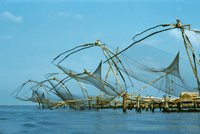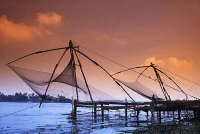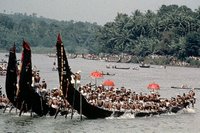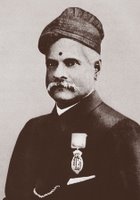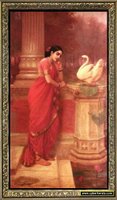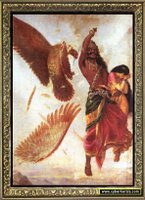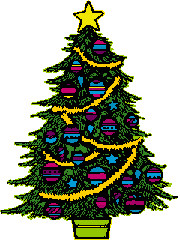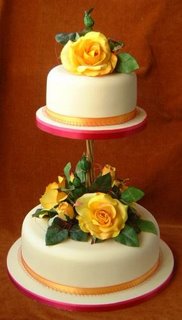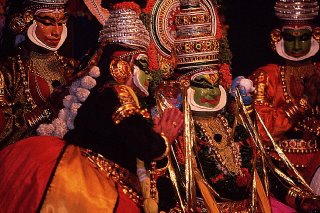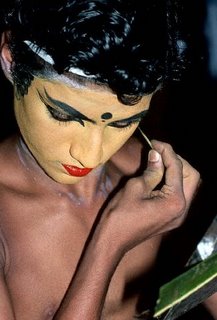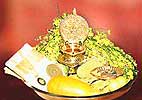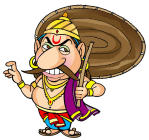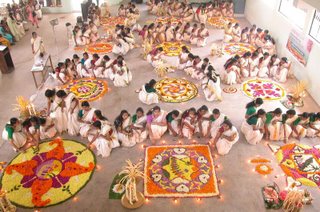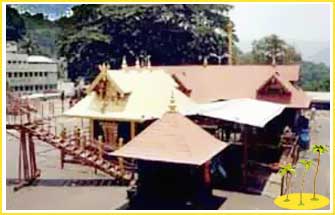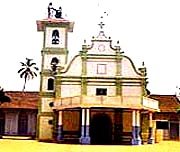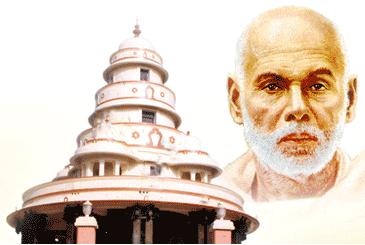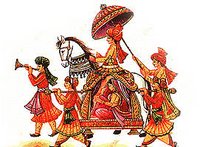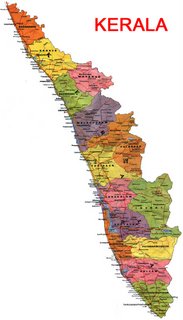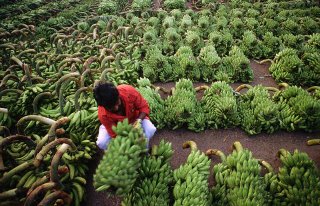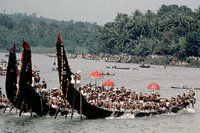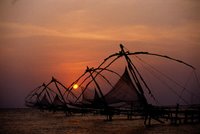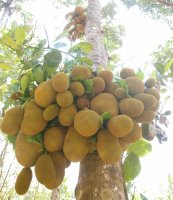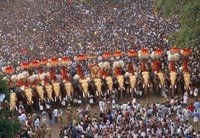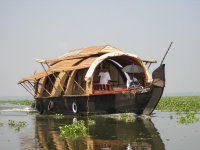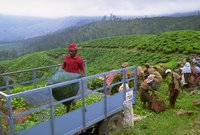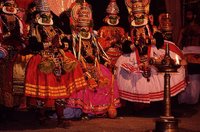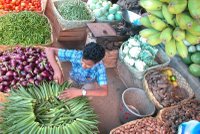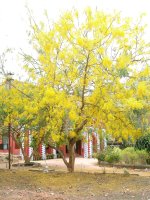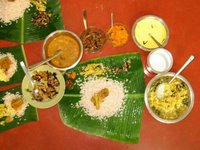Spectacular visual effects and stunning music are hallmarks of Kerala's performing arts. In a land which cannot boast of monumental architectural feats, unlike many other parts of India, the performing arts, both individually and collectively, make up for the lost magnificence. No other State in India can match the grandeur and creativity of Kerala's performing arts. The classical and ritual arts of Kerala have always enjoyed a rich patronage, from the former kings who ruled the state to the latter day democratic governments.
Kerala's unique selling point is its rich culture which was mellowed by centuries-old rich heritage. Culture and heritage are pervasive presence across the state and are kept alive through the state's performing arts.
Below are some art forms of Kerala
KATHAKALI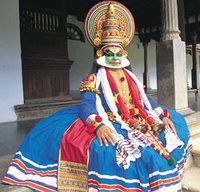
Kathakali is the most refined, most scientific and elaborately defined dance form of Kerala. It is a very exciting art form demanding not only complete control of practically every fibre of the artiste’s body, but also intense sensitivity of emotion. It had its origin in the courts of the Kings of Kerala. It is considered to be a synthetic art form combining in itself the rudiments of its earlier forms like ‘Krshnanattam’ and ‘Ramanattam’ with a highly scientific dance drama form. It is not folk, but highly classical.
MOHINIYATTAM
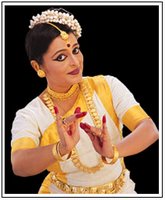
It is a classical solo dance style, which is a blend of the grace and elegance of Bharata Natyam with the strength and force of Kathakali to build a mood of sringara or romance. The dance is usually performed on specially made stages during the temple festivals. The costume for the dance is the traditional white mundu and melmundu of Kerala and with the hairs gathered up at one side of the head and adorned with jasmine flowers in the traditional style.
CHAKKIARKOOTHU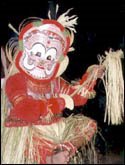
Koothu is a socio-religious art performed in the Koothambalam or the Koothuthara of temples, either independently or as part of Kootiyattam. Chakar Koothu is a mono-act mainly among the upper caste Hindus. It is a solo narrative performance interspersed with mime and comic interludes. . The Chakar (Actor) acts the role of all the characters, to the accompaniment of the "Mizhavu" played by the Nambiar and the Cymbals by the Nangiar. He recites the scriptural poem narrating the stories from the epics (The Ramayana and The Mahabharata), and annotations with witty and humorous examples and anecdotes. There are different versions of Koothu. Some of them are Nangyar Koothu - performed by the Nangiars or the female members of the Chakkiar community. This a solo dance drama centered on the legends of Sree Krishna The art form is performed in temples like Vadakkumnatha temple at Thrissur, Sri Krishna temple at Ambalappuzha, Koodal Manikyam temple at Irinjalakkuda and Kumaranalloor temple at Kottayam.
KALARIPPAYATT
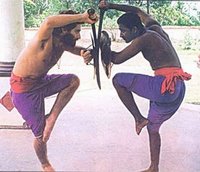
Kalaripayattu is the complete system of martial arts of Kerala. It is considered as one of the oldest and most scientific martial arts in the world. The training of Kalaripayattu aims at the perfect co-ordination of body and mind and the traditional training in a Kalari include specialization in the indigenous medical practices too. Kalaris are also centers of religious worship.
BHARATA NATYAM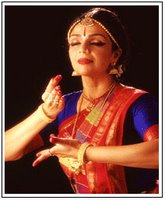
It is the oldest form of classical dance in India. Origin of this style of dance can be traced to the Natya Sastra written around 4000 BC by sage Bharatha. Known as the 'Poetry in Motion', this dance form was originally known as 'dasi attam,' a temple dance performed by young women called 'devadasis.' Bharata Natyam is most commonly performed by women rarely by men. Strict guidelines are laid down describing every single aspect of the dance form including the attributes required to be an accomplished dancer.
THEYYAM
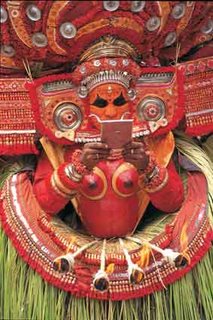
A ritual dance performed in Temples in fulfillment of vows of devotees. Theyyam, the local deity is believed to bless and arbitrate between the farmers and the Landlords. It is purported to be the dance by the Goddess Herself. The dancers are men in feminine attire wearing costumes made of palm leaves, cloth and brass jewellery, ferocious masks and big head gear, some extending up to forty feet in height. The pace of the dance is set to the beating of Chenda (drum). The artiste invested by the goddess in his person falls in a trance, dances deliriously to the mounting tempo and conveys, as an oracle, the goddess's acceptance of the vow and blessings or otherwise.
KRISHNANATTAMKavadiyattam, a colourful ritual art, is a votive offering to Sree Subramanya. Basically of Tamil origin, Kavadiyattam is widely prevalent in the Subramanya temples all over Kerala during the festival seasons. Dressed in bright yellow or saffron robes, devotees performing kavadiyattam smear vibhoothi or sacred ash all over their body. Each one carries on his shoulder an ornate Kavadi - a huge bow, richly decorated with peacock feathers, (it is believed that the peacock is the vehicle of Sree Subramanya). Kavadiyattam literally means dance carrying a kavadi. Kavadies are usually of different sizes and shapes, each with its own significance. A Pookavadi is one decorated with brightly coloured artificial flowers, a mayilpeeli kavadi decorated using only peacock feathers and ambalakavadi, one shaped like the gopuram (tower) of a temple. A kavadi can rise up to a height of 10-18 feet.
The dancers twist and spin in a row. A group of such kavadi dancers make an exotic sight. The dancers gradually move in a frenzy, in step with the rising beats of percussion instruments like udukku, chenda etc., accompanying the procession. Sometimes nadaswaram, a wind instrument, is also used.
VELAKALI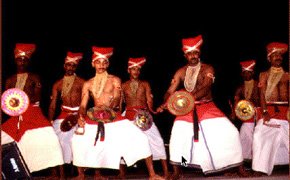
This is a sort of martial dance performed by men. Velakali was originated in Ambalappuzha in Alappuzha district. Mathoor Panicker, chief of the Chempakasserri army, promoted it to boost the martial spirit of the people. The dancers are clad in the traditional clothes and colourful headgear of the medieval Nair soldiers. The dancers engage in vigorous movements and dexterous swordplay, to the accompaniment of an orchestra comprising the maddalam, ilathalam, kombu and kuzhal.
KOODIYATTAM
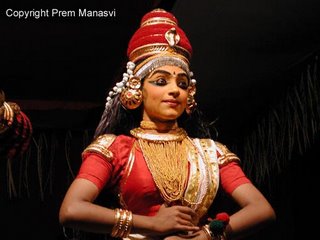
The literal meaning of the title being concomitant dancing, it is another temple opera performed jointly by Chakyars and Nambiars. They present mythological plays in Sanskrit through nine nights. It is an old form of art improved by Poet Thola, now performed only in certain major temples like Irinjalakkuda, Perinjanam, Kottiyur, etc.
Koodiyattam literally means "acting together". Koodiyattam evolved in the 9th century AD, based on Sage Bharatha's 'Natyasasthra' who lived in the second century. Koodiyattam is basically a temple opera performed jointly by Chakyars and Nambiars community. The Chakkiars provide the male cast and the Nangiars playing the female roles. The Nangiars beat the cymbals and recite verses in Sanskrit, while in the background Nambiars play the Mizhavu, a large copper drum. The Koodal Manickyam temple at Irinjalakkuda and the Vadakkumnatha temple at Thrissur are the main centres where Kootiyattam is still performed annually. Ammannoor Madhava Chakkiar is an unrivalled maestro of this rare art.
THIRUVATHIRAKALI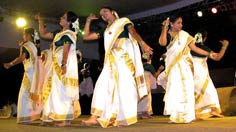
It is a dance performed by women singing in praise of Lord Shiva, to attain everlasting marital bliss. This dance is performed on Thiruvathira day (the sixth lunar asterism) in the Malayalam month of Dhanu (December- January). The dance is a celebration of marital fidelity and the female energy, for this is what brought Kamadeva (the god of love) back to life after he was reduced to ashes by the ire of Lord Siva. The sinuous movements executed by a group of dancers around a nilavilakku ((pedestal wick lamp), embody 'lasya' or the amorous charm and grace of the feminine. The dance follows a circular, pirouetting pattern accompanied by clapping of the hands and singing. Today, Thiruvathirakali has become a popular dance form for all seasons
KALIYOOTTUKaliyoottu is an eight day long colourful folk ritual which reenacts the combat between goddess Durga and the demon Darika. The ritual is performed in different stages. The climax of the play - the ritual called Paranettu - is performed on a specially constructed 100 feet high stage on the eighth day.
KANNIYARKALIKanniyarkali (Deshathukali) is a ritual art dance from, which is performed to the accompaniment of devotional folk songs and the resounding beats of drum. It is usually performed in Bhagavathy temples.
KALAMPATTUKalampattu or Kalamezhuthu Pattu is a folk art form that is practiced in the northern parts of Kerala. More than 600 years old art form, it is performed by a group of five to fifteen people in the Bhadrakali and Ayyappa temples. The ritual is performed around the Kolam, which is an elaborate picture usually of Bhadrakali drawn on the floor with the use five colors. The dance is performed in the light of temple torches continue all through the night. A series of songs or kalampattu are sung to the accompaniment of nanthuni and elathalams.
CHERUMARKALIIt is a harvest dance in which the dancer, both men and women move in a swift rhythm, linked in a back lock or holding arms. The costumes are in striking red and white.
THULLAL & OTTAN THULLAL
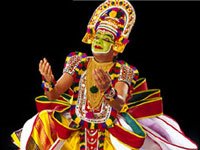
Ottanthullal is one of the most distinguished of all the Thullal arts. The origin of Ottanthullal is really interesting - Kunchan Nambiar, the drummer, was playing Mizhavu for Chakyar koothu. One day, against all precedence, he happened dozed off by sheer inactivity caused by a prolonged talk by the Chakyar after a recital of poem that needed the rhythmic support. When the Chakyar abruptly started reciting another lyric, having had no rhythmic response from the drummer looked back and found him dozing. He not only got him up but also ripped him down by humiliatingly sarcastic comments and jokes on his person. Nambiar hanged his head in shame and silently walked off. Instead of crying over the incident in self-contempt, he sat through the whole night, with a vengeance, and wrote a poem depicting an episode from Mahabharatha in a never-to-fore metric and rhythmic pattern. He also devised a special kind of dance for its exposition. The legend is that he presented it the very next evening at the same temple where he was humiliated on a different platform at the same time the Chakyar had begun. By the novelty, wittiness, enjoyableness and acridity of the programme he attracted all the audiences that had surrounded Chakyar to his show. It was the birth of a new art form that he named as "Ottanthullal".
Impressive costume down the waistline and colourful crown are copied from Kathakali, with slight variations. Ornaments are made up mainly of tender leaves of coconut and beads. It is a solo dance with the artiste himself singing the verses to the accompaniment of Mridangam and timing with a refrain repeater singing in the background. Usually the performance lasts a couple of hours.
KAVADIYATTAMIt is a ritualistic dance form performed by a group of devotees wearing bright yellow or saffron costumes with ash smeared all over the body. The dance depicts Kavads carrying kavadis on their shoulders. The beats of instruments like udukku and chenda and the nadaswaram are integral part of the kavadi procession. It is usually performed in the Subramanya temples.
KOLKALI
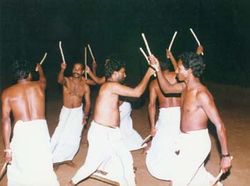
A folk art mainly of the agrarian classes, Kolkkali is a rhythmic dance with the dancers wielding short sticks. The rhythm of this dance is set by a harmonious synchronisation of the tapping of the feet to the striking of sticks. The movement is circular and the artists sing as they dance and strike the sticks in unison. Though the dancers break away to form different patterns, they never miss a beat. In Malabar, Kolkkali is more popular among Muslim men.
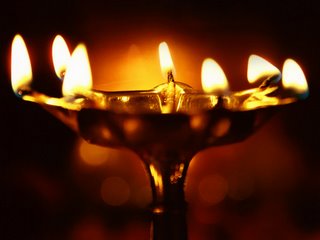
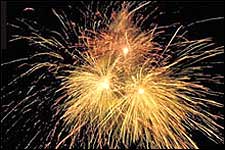 Waking up during the Brahmamuhurta (at 4a.m.) is a great blessing from the standpoint of health, ethical discipline, efficiency in work and spiritual advancement. It is on Deepavali that everyone wakes up early in the morning. The sages who instituted this custom must have cherished the hope that their descendents would realise its benefits and make it a regular habit in their lives.
Waking up during the Brahmamuhurta (at 4a.m.) is a great blessing from the standpoint of health, ethical discipline, efficiency in work and spiritual advancement. It is on Deepavali that everyone wakes up early in the morning. The sages who instituted this custom must have cherished the hope that their descendents would realise its benefits and make it a regular habit in their lives.










